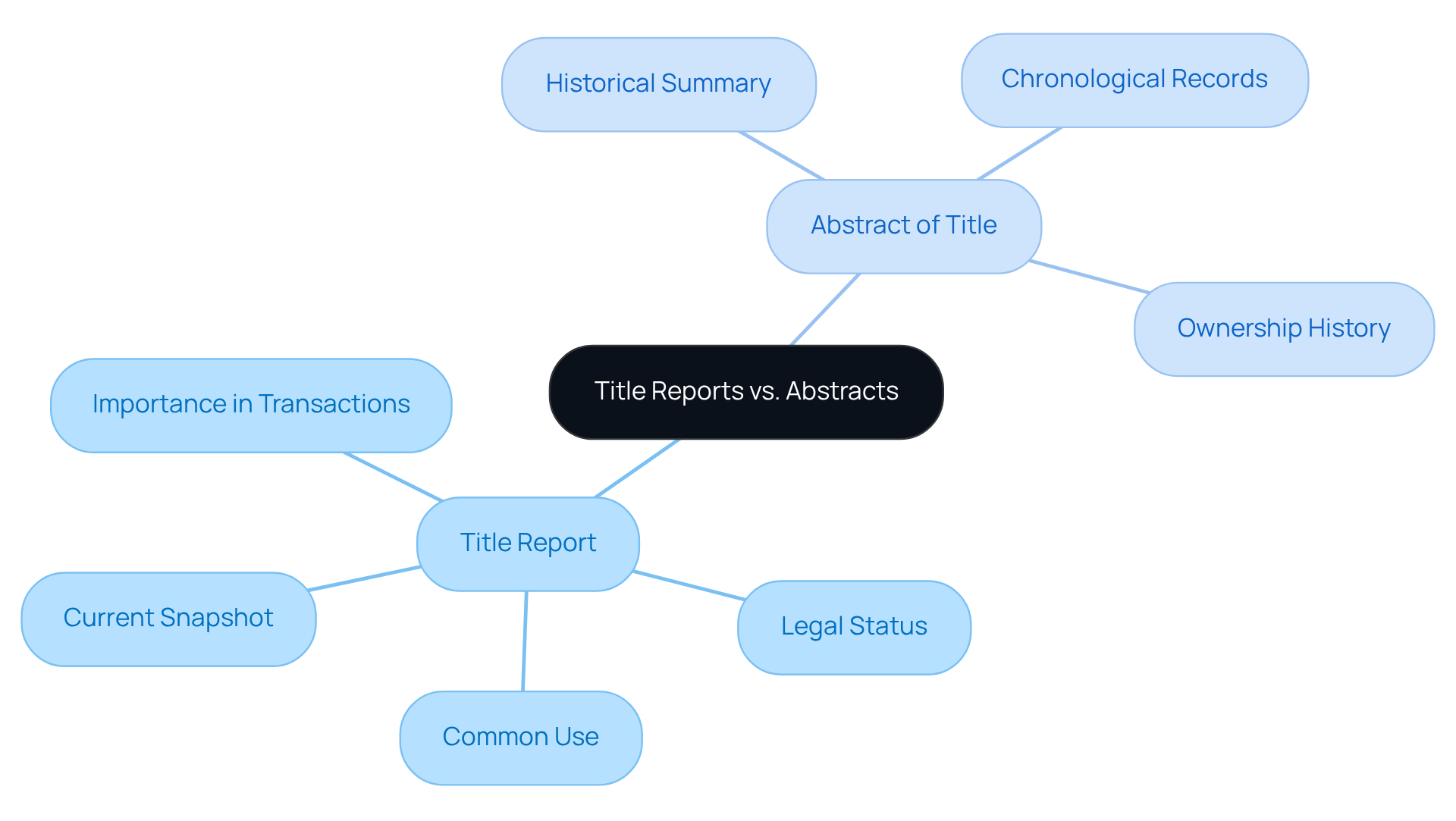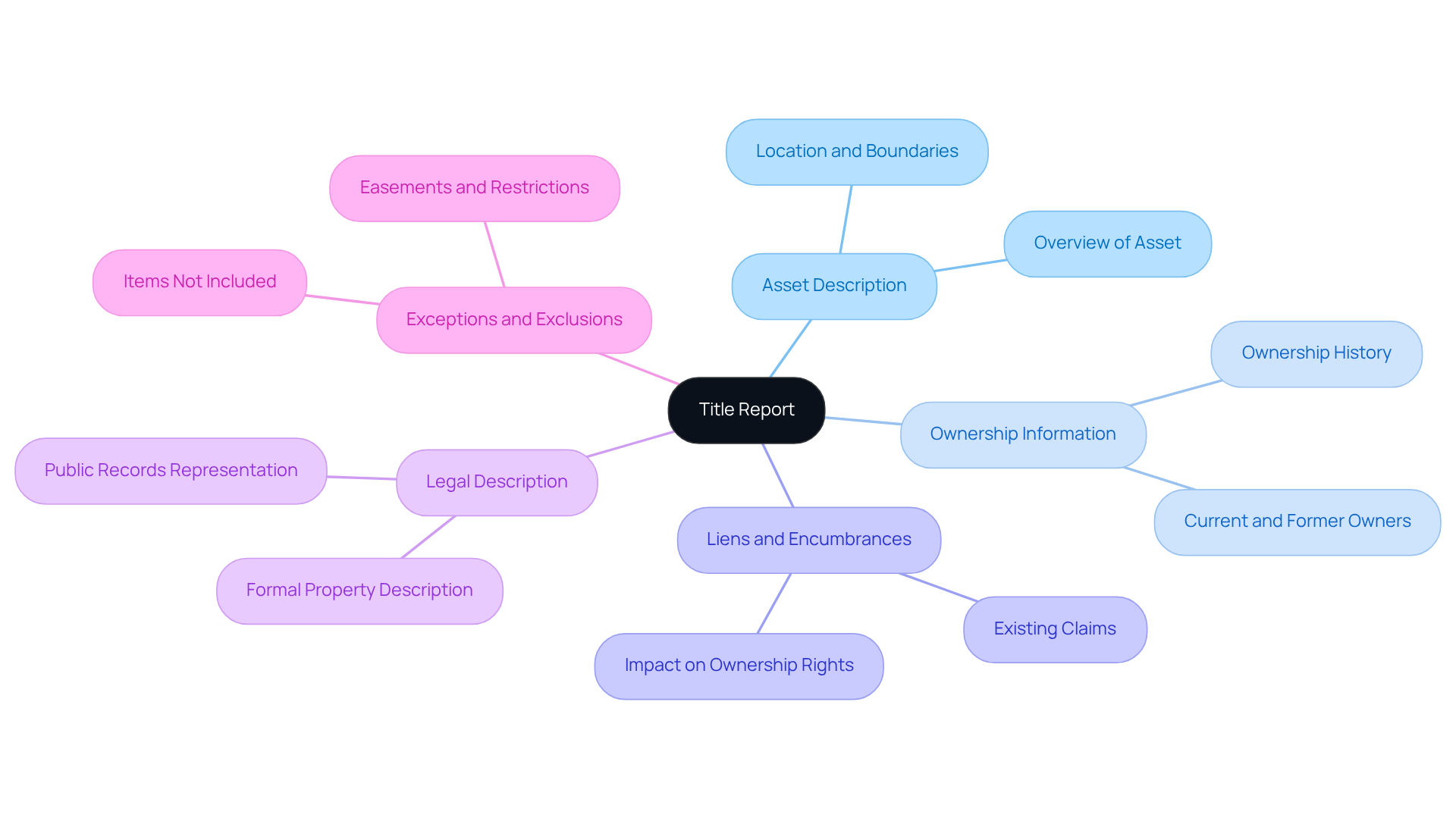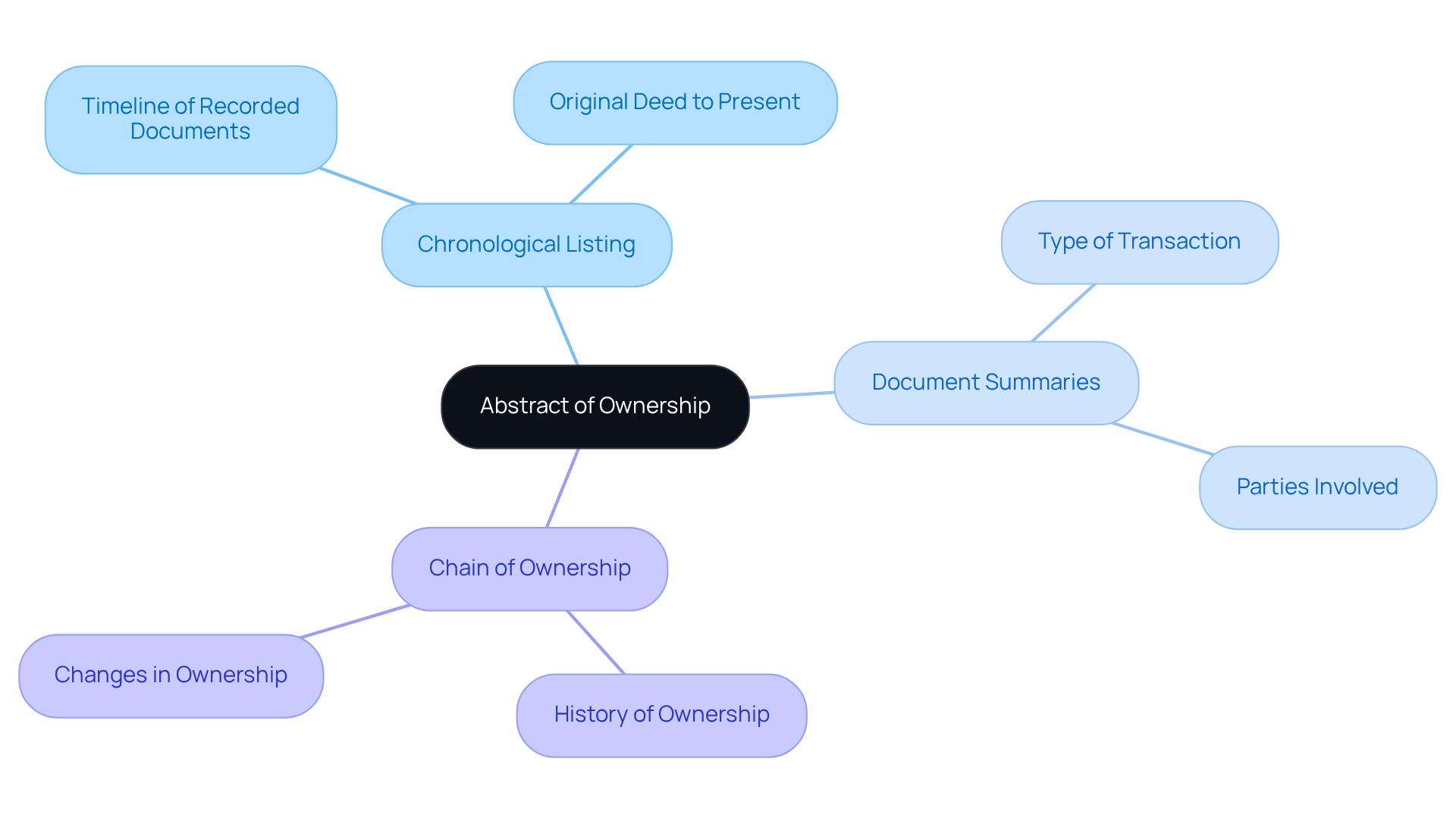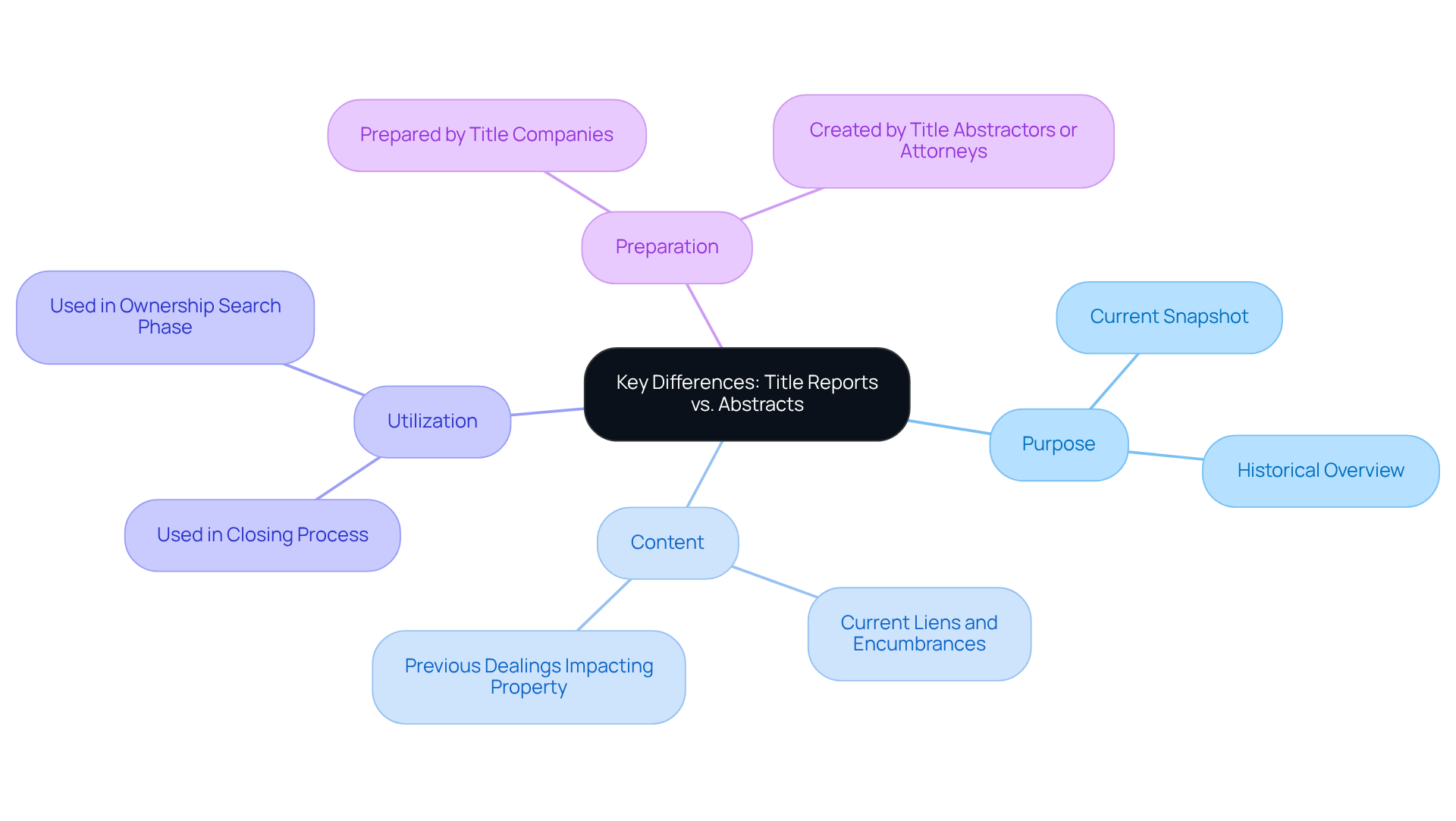Overview
The primary distinction between a Title Report and an Abstract of Title is rooted in their respective purposes and content. Title Reports deliver a current snapshot of a property's legal status, whereas Abstracts provide a historical overview of ownership. This article elucidates that Title Reports concentrate on current liens and encumbrances pertinent to real estate transactions. In contrast, Abstracts summarize all recorded documents influencing ownership over time. Both instruments are crucial in ensuring clarity and security in property dealings, underscoring the importance of accurate title research in navigating real estate transactions.
Introduction
Understanding the nuances of real estate documentation is vital for anyone navigating the property market. Among the most critical documents are title reports and abstracts, each serving distinct yet complementary purposes in confirming ownership and safeguarding investments. However, the confusion surrounding their differences can lead to significant legal pitfalls.
What are the key distinctions between a title report and an abstract? How can a clear understanding of both enhance real estate transactions? By addressing these questions, we can illuminate the path to more secure and informed property dealings.
Define Title Reports and Abstracts
A Title Report is a comprehensive document that illustrates the difference between title report and abstract by providing a current snapshot of the legal status of a property, including any liens, encumbrances, or claims against it. Typically arranged by a title organization, it is crucial for confirming that ownership is clear prior to an agreement. In fact, approximately 80% of real estate transactions necessitate a document review to safeguard against potential legal issues. Engaging a company specializing in property documentation is advisable for conducting a thorough search, as they will appoint an officer to examine the status of a home and offer insurance for ownership.
Conversely, the difference between title report and abstract is that an Abstract of Title acts as a historical summary of all recorded documents associated with a real estate asset. It contains a chronological record of all activities influencing ownership, such as deeds, mortgages, and other legal documents. This document serves as a record of the asset's and is essential for understanding the difference between title report and abstract, which can help identify any potential issues that may arise during a search for ownership. Although the proportion of dealings requiring abstracts is not as frequently referenced, understanding the abstract of title can enhance real estate professionals' methods by providing deeper insights into the property's history. Remarkably, the lack of a comprehensive understanding of these documents, especially the difference between title report and abstract, can lead to significant legal issues, underscoring the importance of both in real estate dealings.

Examine Title Reports: Components and Purpose
A Title Report is an essential document in real estate transactions, comprising several key components that significantly influence the buying process:
- Asset Description: This section provides a comprehensive overview of the asset, detailing its precise location and boundaries, which is vital for identification.
- Ownership Information: It outlines both current and former owners, offering insights into the asset's ownership history and any potential issues arising from previous transactions.
- Liens and Encumbrances: This section enumerates any existing claims against the asset, such as mortgages or tax liens, which can directly affect ownership rights and the buyer's investment.
- Legal Description: A formal description of the real estate as recorded in public records, ensuring that all legal aspects are accurately represented.
- Exceptions and Exclusions: This section specifies particular items not included in the insurance policy, such as easements or restrictions that may limit property use.
The primary objective of a report on ownership is to confirm that the ownership is clear and marketable, thereby providing reassurance to both buyers and lenders before finalizing a deal. With Parse AI's , including the example manager and research automation, the document processing involved in generating reports can be accelerated, enabling quicker and more precise extraction of critical information. Title reports are typically delivered within a few days of reaching an agreement with the seller, facilitating timely decision-making. The cost of document processing averages around $100, while a lender’s policy on a $100,000 loan can range from $175 to $900 depending on the state, making it a relatively low expense compared to other transaction fees.
Understanding ownership information is crucial; it not only safeguards investments but also aids buyers in avoiding potential disputes. As industry expert Edith Reads asserts, "in short, ownership reports provide peace of mind and help protect your investment," highlighting the importance of ownership information in investment protection. Furthermore, ownership documentation generally requires about two weeks, emphasizing the timeline associated with report preparation. Given the increasing complexity of real estate transactions, leveraging Parse AI's automated document processing features can enhance the thoroughness and professionalism of ownership research, ensuring that buyers navigate the report process effectively. Staying informed about the difference between title report and abstract and their implications is more critical than ever.

Analyze Abstracts: Structure and Significance
An Abstract of Ownership is meticulously organized to provide a comprehensive summary of a real estate's legal background. It typically encompasses:
- Chronological Listing: This section presents a timeline of all recorded documents impacting the asset, beginning with the original deed and extending to the present day.
- Document Summaries: Each document is accompanied by a brief description, detailing the type of transaction—such as sale or mortgage—and the parties involved.
- Chain of Ownership: This outlines the history of ownership, illustrating how the asset has changed hands over time.
In 2025, the average Abstract of Title may include numerous documents, reflecting the complexity of real estate transactions. The importance of an abstract lies in its capacity to uncover discrepancies or problems that might not be evident in a standard report. As Tom Sommers notes, understanding the comprehensive ownership history is crucial for making informed decisions in real estate. Furthermore, the reliance on document summaries remains significant for rural land, which frequently encounters challenges such as unclear lot boundaries and easements.
For researchers focusing on real estate, a summary acts as an essential instrument, ensuring that all facets of a legal situation are meticulously reviewed. This diligence promotes more seamless exchanges and in real estate dealings. In addition, while title insurance has emerged as a modern alternative, providing protection against ownership disputes, the historical importance of abstracts in real estate transactions cannot be overlooked. They continue to play a vital role in ensuring clarity and security in property dealings.

Compare Title Reports and Abstracts: Key Differences
The key differences between Title Reports and Abstracts are essential for real estate professionals to understand:
- Purpose: Title reports provide a current snapshot of the document's status, whereas abstracts offer a historical overview of ownership.
- Content: Title reports concentrate on current liens and encumbrances, while abstracts outline all previous dealings impacting the property.
- Utilization: Ownership reports are typically employed in the closing process of a real estate transaction; conversely, abstracts are frequently utilized during the to uncover historical issues.
- Preparation: Title reports are prepared by title companies, whereas abstracts can be created by title abstractors or attorneys.
Understanding the difference between title report and abstract is crucial for effectively navigating the complexities of property ownership verification.

Conclusion
Understanding the distinction between a Title Report and an Abstract is crucial for anyone involved in real estate transactions. A Title Report provides a current view of the legal status of a property, detailing any claims or encumbrances. In contrast, an Abstract offers a historical account of ownership and transactions related to the property. Both documents play essential roles in ensuring that ownership is clear and marketable, thus safeguarding investments and facilitating smoother real estate dealings.
Throughout this article, we have dissected the key components and purposes of both documents. Title Reports focus on present liens and ownership details, while Abstracts chronologically outline the entire history of property ownership. Engaging with these documents aids in uncovering potential legal issues and enhances the decision-making process for buyers and sellers alike. The insights shared emphasize the importance of utilizing both documents in real estate practices, as they complement each other in verifying property ownership and mitigating risks.
In light of the complexities inherent in real estate transactions, a thorough understanding of both Title Reports and Abstracts can significantly impact the success of property dealings. Real estate professionals and buyers are encouraged to leverage this knowledge to navigate ownership verification effectively. By doing so, they can ensure not just peace of mind but also a more secure investment in their real estate endeavors.
Frequently Asked Questions
What is a Title Report?
A Title Report is a comprehensive document that provides a current snapshot of the legal status of a property, including any liens, encumbrances, or claims against it. It is crucial for confirming clear ownership prior to a real estate agreement.
Why is a Title Report important in real estate transactions?
A Title Report is important because it helps safeguard against potential legal issues by confirming that ownership is clear. Approximately 80% of real estate transactions require a document review to ensure this clarity.
What role does a title organization play in preparing a Title Report?
A title organization arranges the Title Report and appoints an officer to examine the status of a home, ensuring a thorough search and offering insurance for ownership.
What is an Abstract of Title?
An Abstract of Title is a historical summary of all recorded documents associated with a real estate asset. It includes a chronological record of activities influencing ownership, such as deeds and mortgages.
How does an Abstract of Title differ from a Title Report?
The main difference is that a Title Report provides a current snapshot of a property's legal status, while an Abstract of Title serves as a historical record of ownership and related documents.
Why is understanding the Abstract of Title important for real estate professionals?
Understanding the Abstract of Title enhances real estate professionals' methods by providing deeper insights into a property's history, which can help identify potential issues during ownership searches.
What are the potential consequences of not understanding the difference between a Title Report and an Abstract of Title?
A lack of understanding of these documents can lead to significant legal issues in real estate dealings, highlighting the importance of both in ensuring clear ownership and avoiding disputes.




